This section describes terms related to RAN (Radio Access Network), which is a mobile wireless access network. This blog post will explain the difference between CRAN (Centralized-RAN) and DRAN (Distributed-RAN). It also describes the BBU Pooling technology used in CRAN deployments.
What is RAN (Radio Access Network)?
5G and 4G mobile networks are broadly divided into radio access networks (RAN) domain and core networks (CN) domain. The figure below shows the 5G RAN and 5G core network (5GC).
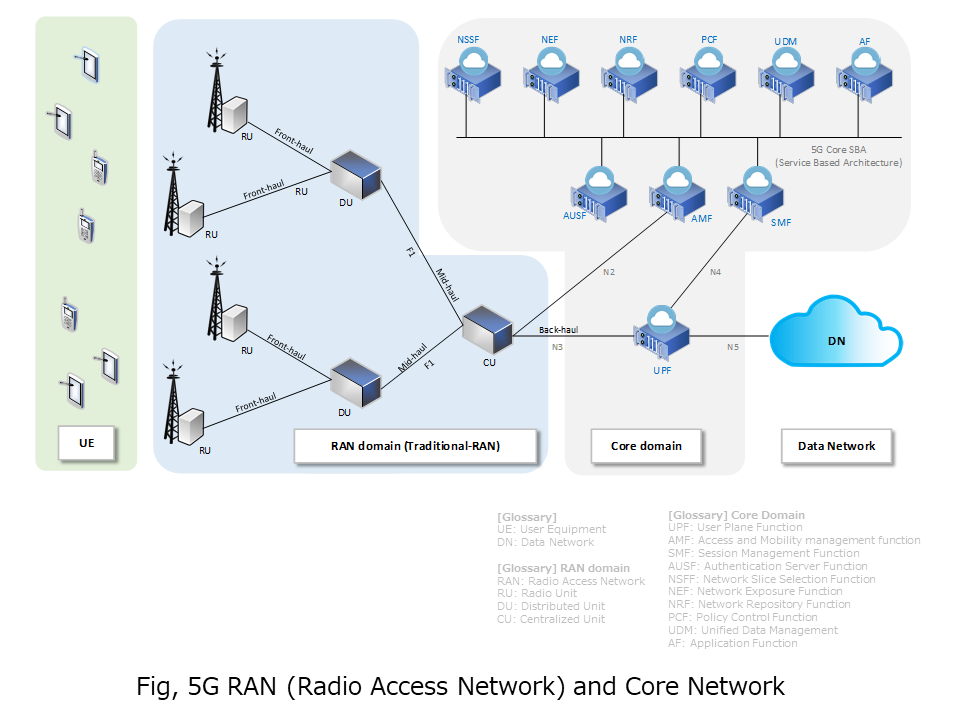
- [Glossary]
- RU: Radio Unit
- DU: Distribution Unit
- CU: Cauterized Unit
- DN: Data Network
- UE: User Equipment
RAN is Radio Access Network in 5G or 4G mobile network. RAN is a network for connecting terminals such as mobile phones (smartphones) to the core network through wireless connection. RAN is a network for controlling wireless connectivity between mobile phones (smartphones) and base station antennas.
Difference between CRAN and DRAN
Radio access networks have different deployment methods for DRAN and CRAN. The difference between DRAN and CRAN is depending on where the BBU (Base Band Unit) that performs baseband processing is placed.
What is DRAN (Distributed-RAN)?
In DRAN, the BBU that performs baseband processing is placed near the Radio Unit (RU). In 3G (3rd Generation Mobile Communication) and 4G (4th Generation Mobile Communication), there was only a deployment method for this DRAN. In 5G case, This DRAN deployment method is used in areas with a small population.
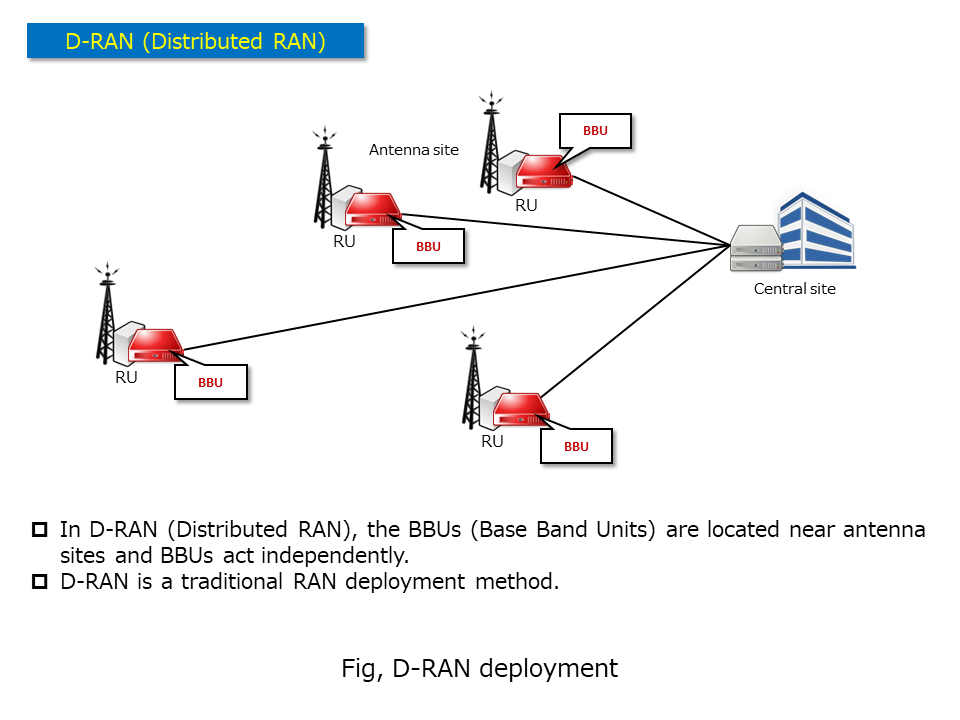
What is CRAN (Centralized-RAN)?
In CRAN, BBUs that perform baseband processing are centrally located in the central site (regional edge site). CRAN is a relatively new technology and is a RAN deployment method used in populated areas.
In 5G, the difference between DRAN and CRAN is selected as the difference in the RAN deployment method, depending on the location where the 5G wireless area is deployed and the plan of the mobile network carrier.
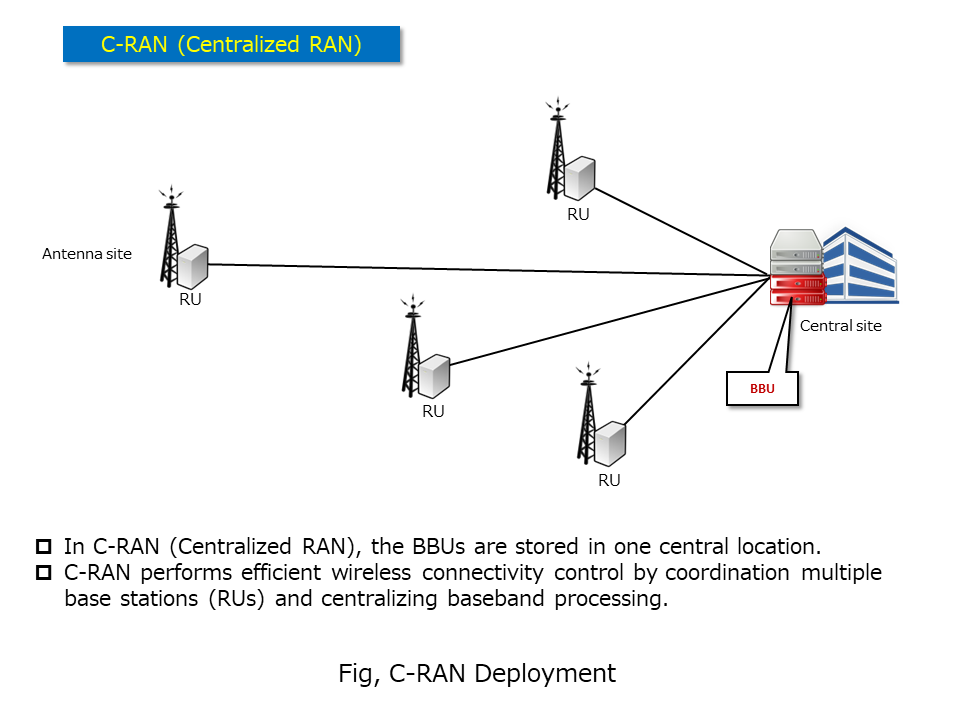
Comparison of DRAN and CRAN
The table below summarizes the differences in RAN deployment and the differences between DRAN and CRNA. (Reference information: linkedin post link.)
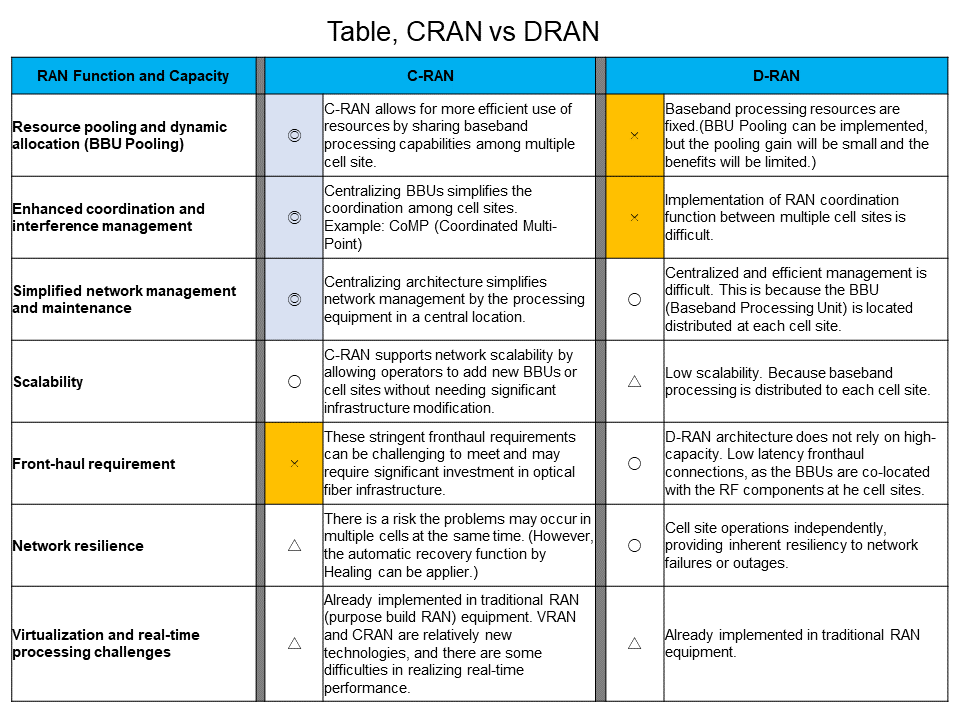
The advantage of DRAN is that the distance of the fronthaul (optical fiber connection between RU and DU) is short, and the effort and cost of wiring work is low.
The advantage of CRAN is that it allows BBU pooling by consolidating baseband processing equipment. Additionally, it is easy to implement functions such as wireless interference control that allows coordination between separate RUs.
Detail about CRAN(Centralized-RAN)
Benefits of CRAN
By installing the baseband processing unit (BBU) in the central station, CRAN can assign the baseband processing resources to the required RU according to the traffic situation. This method allows operator to flexibly use expensive wireless processing resources depending on the traffic situation.
In the DRAN deployment method, baseband processing resources that take into account the maximum traffic expected for each RU are fixedly installed for each RU. However, in CRAN, baseband processing resources are dynamically assigned to the RU as needed. Therefore, with CRAN, the waste of baseband processing resources is greatly reduced for RAN as a whole.
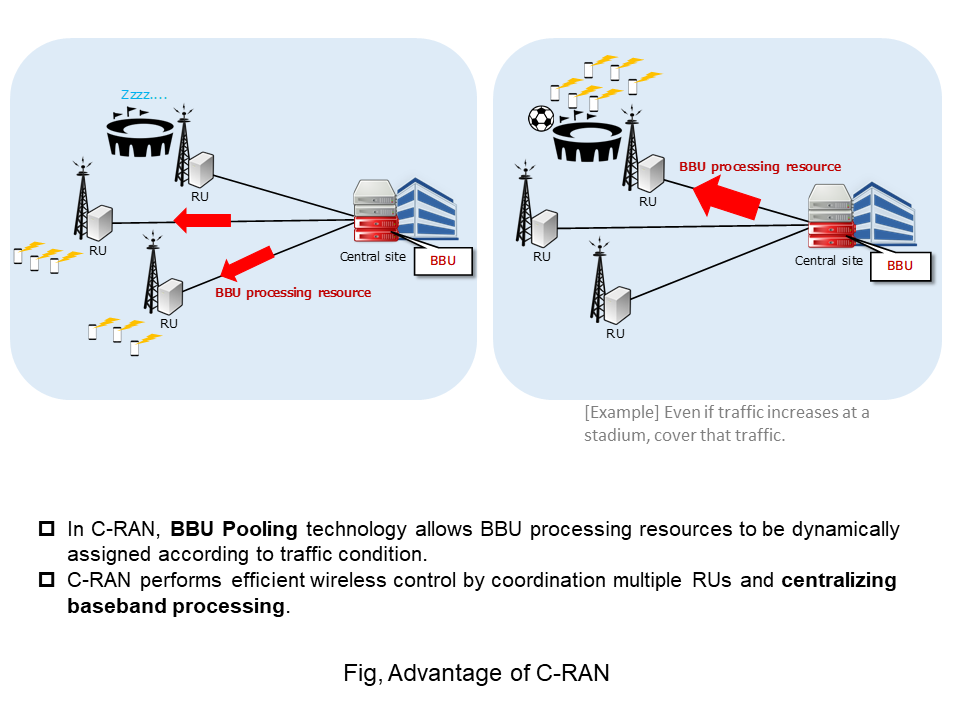
What is BBU Pooling?
BBU Pooling is a technology that consolidates baseband processing resources into a central site and provides the necessary baseband processing resources only to the required RUs. BBU Pooling has been standardized by standards bodies such as the O-RAN alliance.
BBU Pooling is based on processing resources pooling technology in the cloud technology field. BBU Pooling applies this pooling technology to the baseband processing of wireless mobile networks.
Please refer to the following article for the standardization activities of O-RAN alliance.
BU Pooling is based on pooling technology for processing resources in the cloud field. BBU Pooling is an application of this pooling technology to baseband processing in wireless networks.
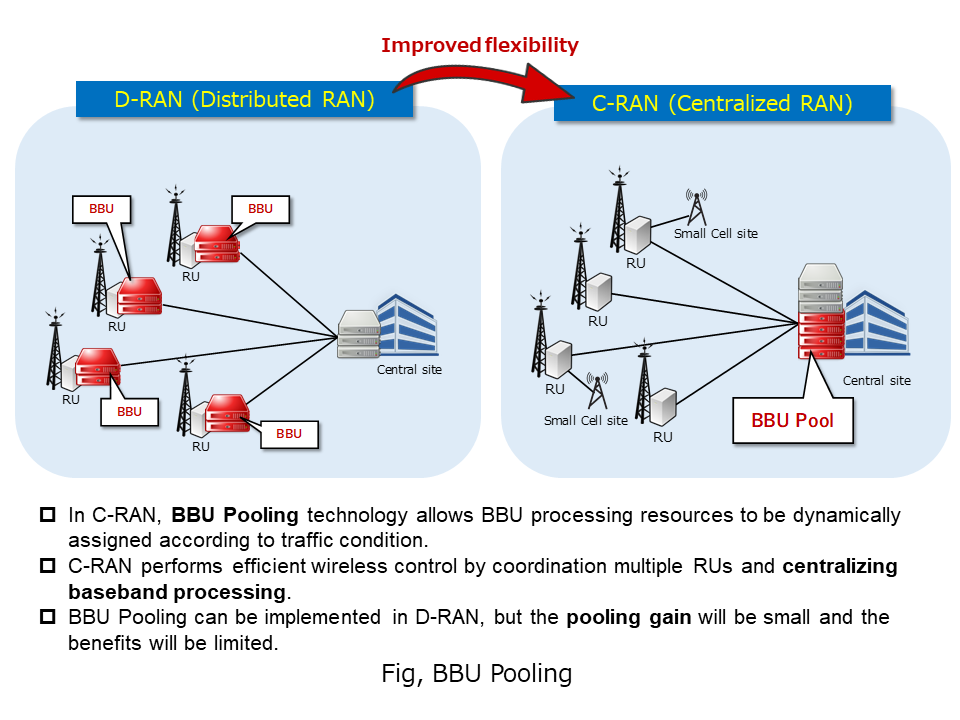
The processing device that performs wireless control is called a baseband unit (BBU). The baseband unit performs signal processing and protocol control. This wireless control processing is called baseband processing.
In 5G and 4G radio access networks (RAN), this baseband processing is extremely heavy processing and requires a large amount of expensive equipment. BBU Pooing allows baseband processing resources to be used efficiently throughout the RAN.
In addition, this BBU Pooling allows you to respond to unexpected problems and server malfunctions in servers that perform RAN baseband processing (healing technology).
Technology trends from DRAN to CRAN
The trend is to use CRAN for 5G RAN and 4G RAN deployments in highly populated areas. By deploying CRAN in urban centers or urban areas, it becomes easier to use baseband processing resources efficiently and control radio interference through cooperation between URs.
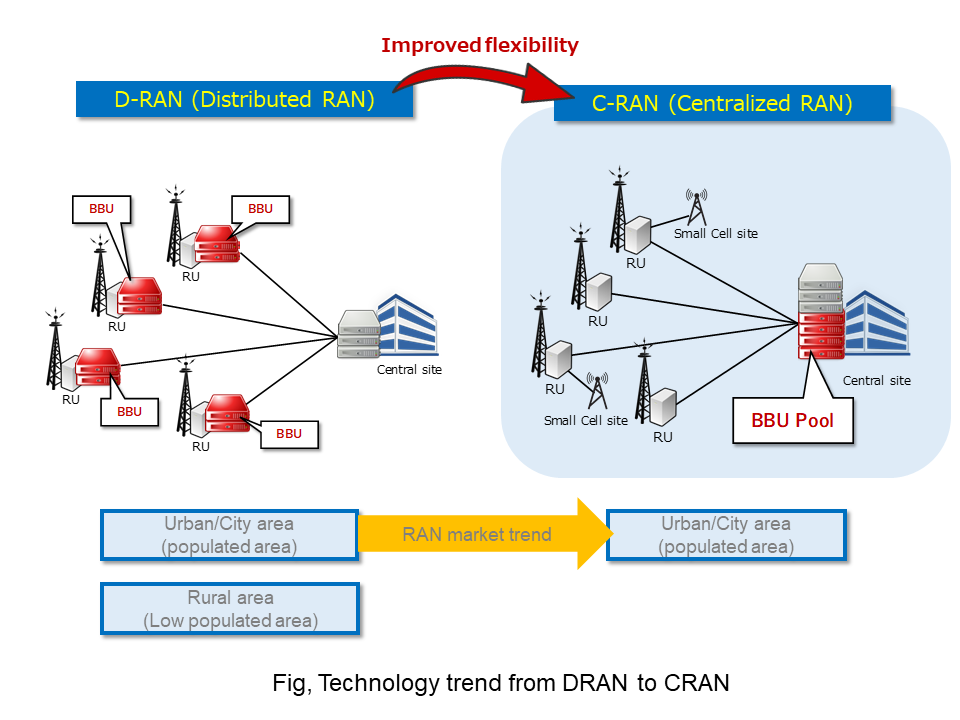
CRAN deployment as a Heterogeneous Network (HetNet)
CRAN is often deployed as a Heterogeneous Network (HetNet). HetNet is a network that is deployed by coordinating various types of base stations with different transmission power, such as small cell base stations, in addition to macro cells that cover a wide area. (In a broader sense, it is a combination of different networks such as 5G, 4G, 3G and WiFi.)
In a heterogeneous network, cooperation between different frequencies is performed as CA (Carrier aggregation). Additionally, FeICIC (Further Inter-Cell Interference Coordination), in which multiple RUs cooperate to cancel interference, and CoMP (Coordination Multi-Point), in which multiple RUs cooperate to control transmission and reception, are used.
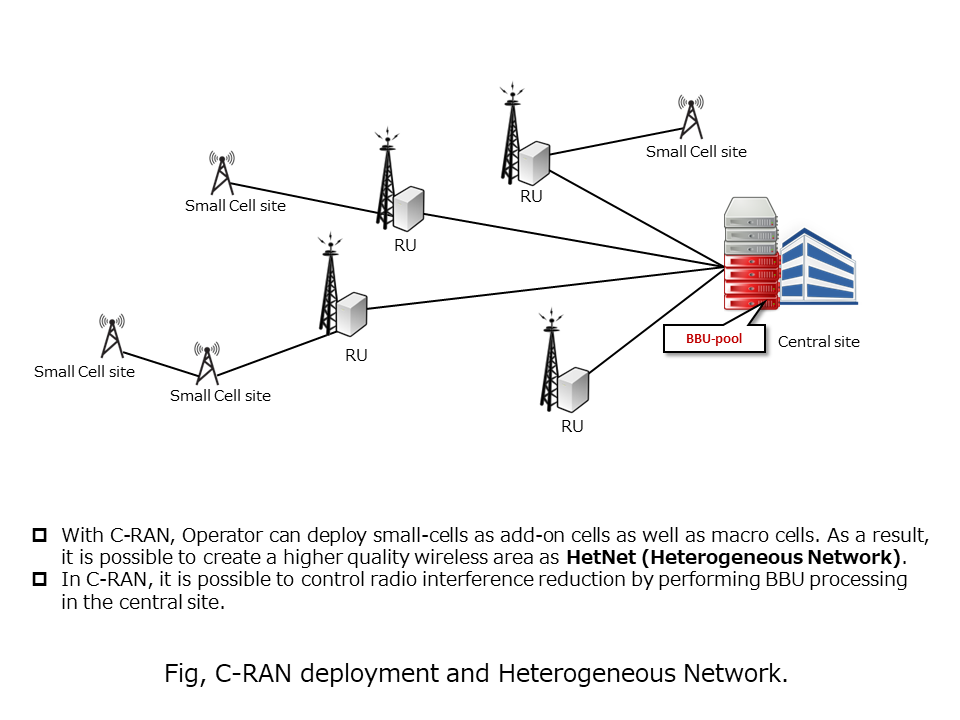
5G Base Band Processing and 5G Protocol Stack
The RAN performs protocol processing to control wireless connections of devices such as mobile phones (smartphones). Part of that protocol processing is baseband processing.
Baseband processing refers to the processing of Layer 1, Layer 2 (MAC and RLC), and Layer 3 above the physical layer of signal processing performed in RAN. (This is processing in a layer higher than modulation and demodulation processing.)
Baseband processing also includes Layer 1 physical processing, MAC, and RLC processing that requires real-time performance.
The figure below shows an example of an overview of 5G protocol processing (control signals).
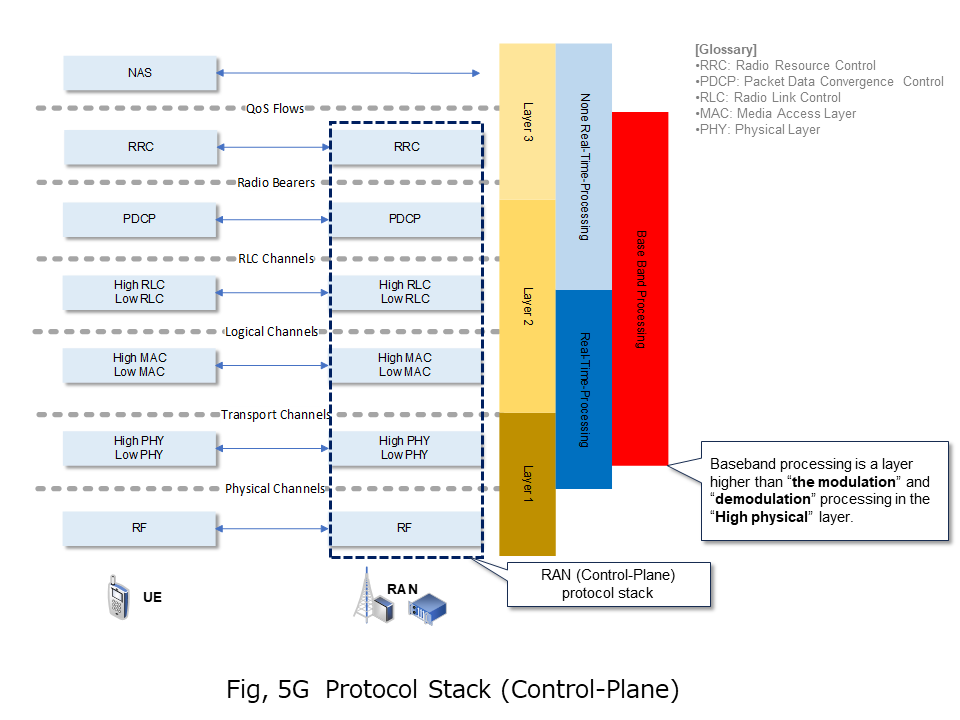
The figure below shows an example of an overview of 5G protocol processing (user data).

- [Glossary]
- RRC: Radio Resource Control (Layer 3)
- SDAP: Service Data Adaptation Protocol (Layer 2)
- PDCP: Packet Data Convergence Control (Layer 2)
- RLC: Radio Link Control (Layer 2)
- MAC: Media Access Layer (Layer 2)
- PHY: Physical Layer (Layer 1)
Summary
This blog post described RAN (Radio Access Network), a mobile wireless network. In particular, we explained the difference between CRAN (Centralized-RAN) and DRAN (Distributed-RAN). We also explained the advantages of CRAN and the BBU Pooling technology used in CRAN.
Please refer to the following blog post for RAN virtualization and VRAN (Virtual-RAN) and ORAN (Open-RAN).





コメント